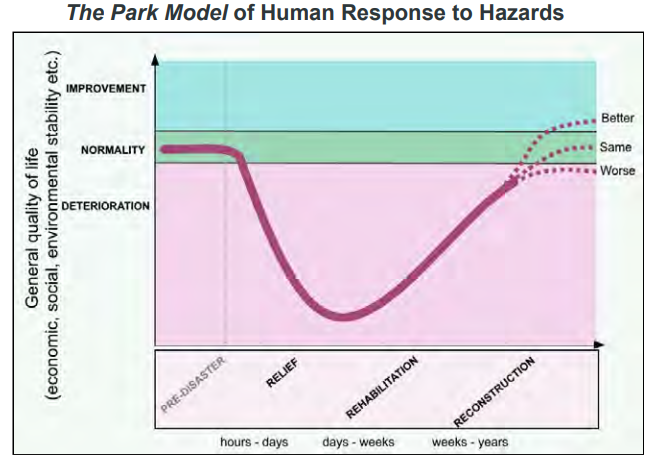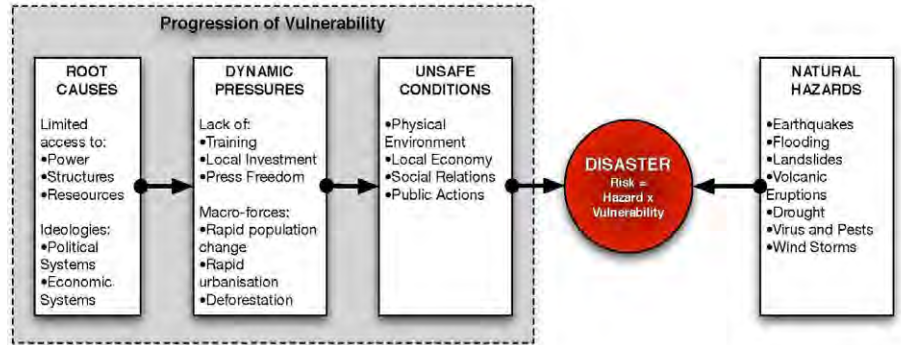Tectonics - EQ3.8
1/24
Earn XP
Description and Tags
Theoretical frameworks can be used to understand the predication, impact and management of tectonic hazards.
Name | Mastery | Learn | Test | Matching | Spaced |
|---|
No study sessions yet.
25 Terms
Equation for risk
Risk = (Hazard x Vulnerability) / Capacity to cope
Degg’s model
Hazards should not be confused with natural disasters
A disaster only happens when a vulnerable population encounters a hazard
If the population is not vulnerable, the disaster will have little effect and not be disastrous
Classifying a tectonic hazard
International Disaster Database = a disaster is when 100+ are affected and 10+ die
UNISDR = a serious disruption of the functioning community or society involving widespread losses and impacts which exceed their capacity to cope
The economic cost of the disaster should also be considered e.g. jobs lost, cost of repairs, economic productivity lost
The Park Model
A graphical representation of human responses to hazards showing the steps carried out overtime of the recovery after a hazard
The steepness of the curve shows how quickly an area deteriorates + recovers
The depth of the curve shows the scale of the disaster

Park - Stage 1 - Relief - hours to days
Immediate local response
Immediate appeal for foreign aid
Park - Stage 2 - Rehabilitation - days to weeks
Services begin to be restored
Temporary shelters + hospitals set up
Food + water distributed
Coordinated foreign aid e.g. peacekeeping forces
Park - Stage 3 - Reconstruction - weeks to years
Restoring the area to the same (or better) quality of life
Area back to normal - ecosystem restored, crops grown etc.
Infrastructure rebuilt
Mitigation efforts for a future event
Park - comparison with other hazards
The Park disaster response curve acts as a control line to compare hazards.
An extremely severe hazard would have a steeper curve and a slower recovery line
The Pressure and Release Model (PAR)
Used to analyse factors which cause a population to be vulnerable to a hazard
One side has the hazard itself whilst the other has factors and processes which increase a populations vulnerability to the hazard

PAR - Root causes
Often caused by economic, demographic and/or political processes which affect large populations or entire countries
PAR - Dynamic pressures
Local economic or political factors that can affect a community or organisation
PAR - Unsafe conditions
The physical conditions that affect an individual e.g. unsafe building, low income, poor health
PAR - Progression of vulnerability
The number of people affected will increase the closer the factor is to the root cause
Example of the PAR model
Unsafe conditions - A lack of infrastructure, e.g. poor sewage, can worsen the impacts of a hazard as it’s harder to maintain clean living conditions. This lack of infrastructure would be a factor of unsafe conditions
Dynamic pressure - However, this lack of infrastructure may be due to rapid urbanisation where little planning had been taken to carefully construct house and infrastructure to cope with this. Rapid urbanisation would be the dynamic pressure
Root cause - Ultimately, planning and controlling safe population growth is the governments responsibility, so the root cause of this disaster may have been weak governance
Common Root Causes (PAR)
Weak governance
Mismanagement by Industry, NGOs or IGOs
High reliance on products easily affected by hazards e.g. agriculture
Common Dynamic Pressures (PAR)
Lack of training/knowledge in locals
Rapid urbanisation
Poor communication between government and locals
Lack of basic services e.g. health, education
Common Unsafe Conditions (PAR)
Lack of infrastructure e.g. clean water, sewage removal
Dangerous location of settlements e.g. close to the hazard itself
No warning system for locals
Disease and fire can spread easily between households
Types of vulnerability
Physical - living in a hazard prone area
Economic - people risk losing employment, wealth or assets during a hazard
Social - communities are unable to support their disadvantaged, leaving them at risk
Knowledge - individuals lack training or warning to know the risks or a hazard + how to evacuate safely
Religious - religion + beliefs may limit their understanding; they are an act of God so don’t mitigate (fatalist beliefs)
Environmental - increased risk due to high population density
Tectonic Hazard Profiles
Compare the physical characteristics which all hazards share.
They can help decision makers when deciding where to allocate the most human and financial resources
The characteristics of a hazard profile
Frequency - How often it happens
Magnitude - Size of hazard
Duration - How long the event lasts
Speed of onset - Warning before occurence
Spatial predictability - Is there a pattern to where it happens
Areal Extent - How big of an area does it cover
Evaluating the effectiveness of models
They can be useful, but the unpredictability of hazards make them less effective at accurately representing human responses to hazards
Can they be applied to every hazard? Do some need a more complex model?
Does it take any aspects of hazards into account like development?
Is there any timeframe?
Could the model be less vague and include more steps?
Does it present hazards currently and taken account of climate change?
VEI - Volcanic Explosivity Index
Measures relative explosiveness of a volcanic eruption
Based on height of ejected material and duration
Scale goes from 0-8
Increase of 1 on the scale indicates a 10x more powerful eruption (logarithmic)
The Modified Mercalli Scale
Measures the destructiveness of an earthquake
Relative scale as people feel different amounts of shaking in different places
Subjective - it’s based on waking up, furniture moving + damage to structures
Scale varies from I to XII
I = not very severe
XII = Nearly total destruction
Moment Magnitude Scale
Measures amount of energy released in an earthquake
Scale from 0-9
Environmental or social impacts must be inferred as it’s a simple measure
Richter Scale
Measures magnitude of waves produced during an earthquake
Most widely used scale as it’s absolute
Must infer social or environmental impacts which can be misleading
The highest scale earthquake readings won’t necessarily be the worst disasters
Logarithmic (x10 per scale increase like VEI)
Technically no upper limit